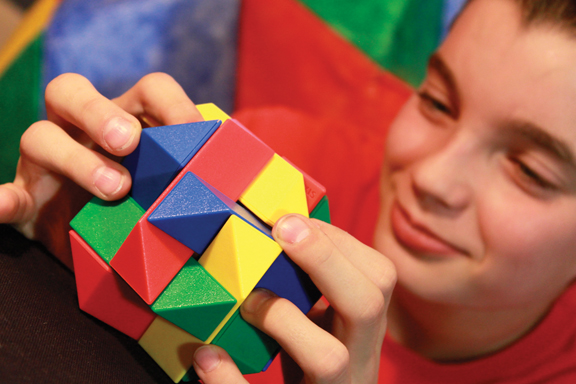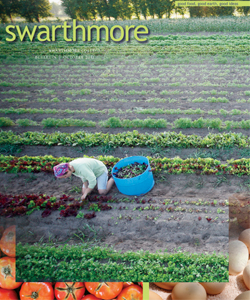Playtime with a Snap
Woodworking artisans John and Jane Greenberg Kostick ’88 have created Tetraxis, a magnetic geometry puzzle for all ages.
Inviting the inner child to re-emerge for playtime, the colorful displays at Toy Fair 2011 in New York enticed industry professionals to play hide-and-seek on three expansive floors.
During mid-February, toy creators and merchants at the Jacob Javits Convention Center dazzled potential buyers with eye-catching gimmicks—from an inflatable remote-controlled flying fish to a shiny red, miniature piano and an oversized lego-constructed car. In a basement-floor booth, John and Jane Kostick encouraged visitors to play with their magnetic Tetraxis geometry puzzle.
“If you put the pieces together in less than one minute, you’ll win a free one,” Jane said to Tom Cutrofello, mechanical puzzle correspondent for Games Magazine.
Twelve identically shaped sticks, in four colors, magnetically connect in the Kosticks’ hands-on learning puzzle, which enhances the exploration of symmetry and color combinations. The toy increases spatial understanding; problem-solving skills; intellectual and manual dexterity; and intergenerational, interoffice, and intercommunity connections.
On the first day of the fair, the crowd around the Kosticks’ table cheered Cutrofello and others, who claimed their prizes after solving the puzzle. Some recalled solving other math-based puzzles and used that experience to handle the Tetraxis challenge.
“That’s a fun toy, especially when you get the method down,” says Jon Goehring, who runs Toyworks in Santa Rosa, Calif., with Cristi Ronchelli.
The Tetraxis design, first crafted as bronze and wooden sculptures, is just one of the geometric constructions that the Kosticks have created. Their customized furniture, cabinetry, and garden accessories are also based on geometric configurations.
“Many of the skills we’ve acquired as builders and craftsmen—to think in details and problem solve—have been critically important in developing the toy version and overseeing production. But the fabrication process is different, because the toy is manufactured out of injection-molded ABS (acrylonitrile butadiene styrene) plastic, a more high-tech process than we are accustomed to and one we really knew very little about when we began developing the product in 2009,” Jane says. “We could never have done it without the help of the product development firm in Watertown, Mass., called DaTuM3D: Design to Manufacture. We worked closely with the company’s industrial designers and engineers to develop our product.”
Designers and woodworking craftsmen with an interest in mathematics, the Kosticks officially launched their new company, KO Sticks LLC, in August 2010. A pilot run of 2,000 toys, in the fall, quickly sold out. The next production in Xiamen, China, delivered the second batch in March for distribution in Switzerland and Australia, where the puzzle was displayed at another toy fair. A small community of artists, primarily furniture makers who work in cooperative studios in an old industrial building—where the Kosticks are based in Medford, Mass.—offered input on the package design.
Patricia Marx, who gave Tetraxis a top rating in the category “Educational Toy That Could Pass for a Real Toy” wrote in The New Yorker (Dec. 6, 2010): “It’s challenging but not throw-it-across-the-room challenging. Bonus points for knowing that the structure is arranged along directions common in nature, similar to carbon or silicon atoms. This factoid also makes for a dandy conversation stopper.”
Some game players have even completed the puzzle blindfolded.
“Once you learn the puzzle, it gets easier and easier,” says Jane. “It always surprises me when I see people struggle with it at first. Then, when they get good at it, they are surprised they initially found it hard.”
“The toy continues to be satisfying to assemble even after it becomes easy,” she says. “One of John’s friends wrote me this morning and said, ‘I keep mine on my kitchen table, and everyone who comes over has to pick it up and put it together again. Yes, it’s like an exercise in life—things fall apart and then you have to build it up again stick by stick. It works. It’s a meditation.”
 Email This Page
Email This Page
